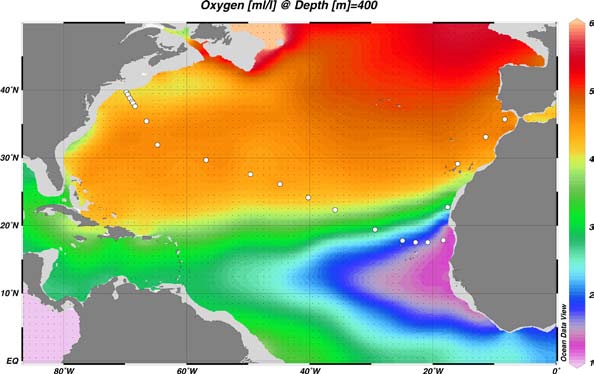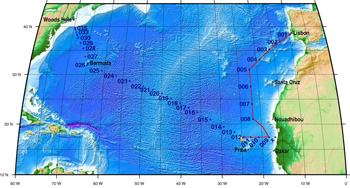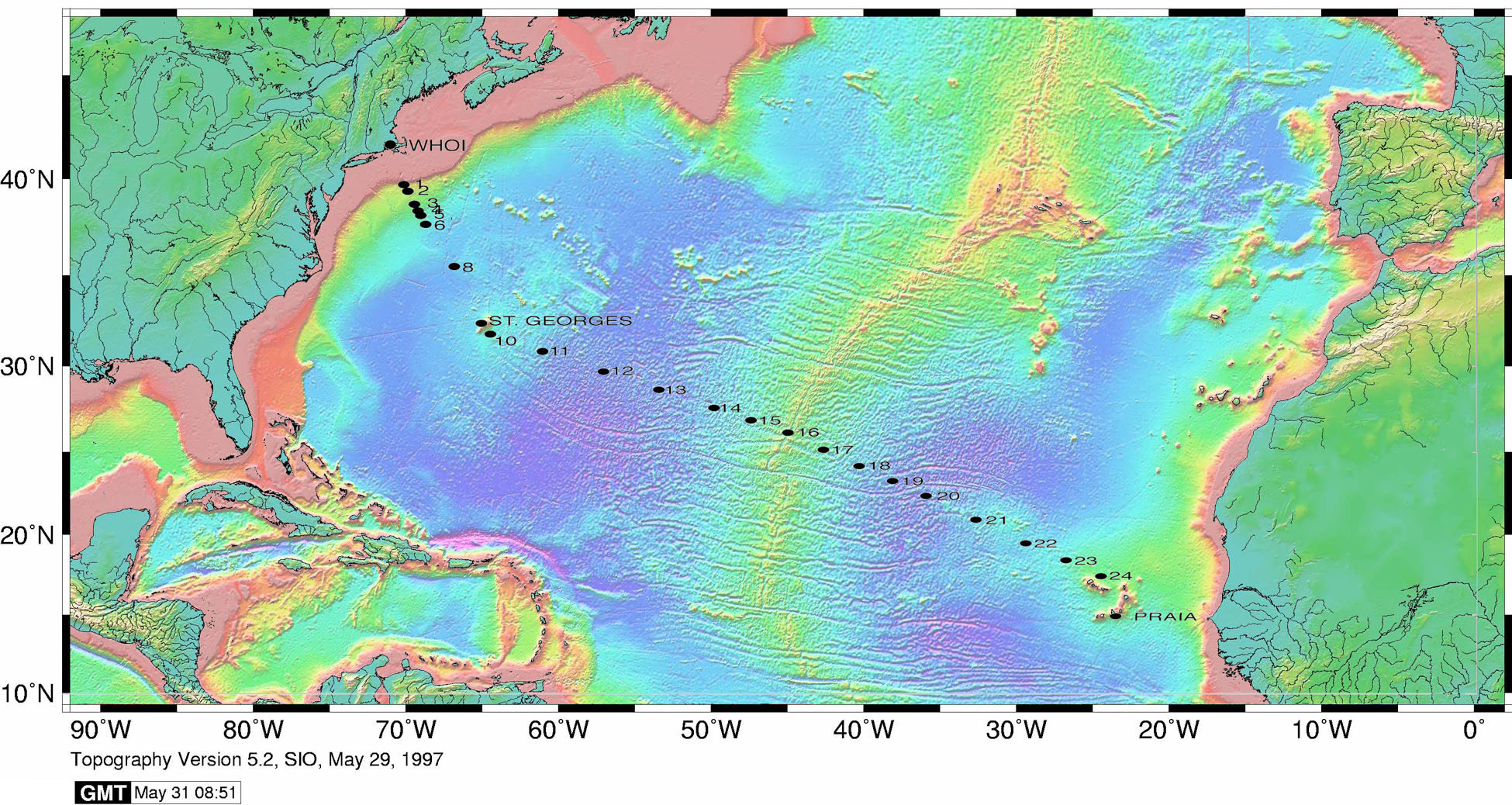Depth profiles for arsenic and antimony speciation and alkaline phosphatase activity from R/V Knorr cruise KN204-01 in the Subtropical North Atlantic Ocean in 2011 (U.S. GEOTRACES NAT project)
Project
Program
| Contributors | Affiliation | Role |
|---|---|---|
| Cutter, Gregory A. | Old Dominion University (ODU) | Principal Investigator |
| Wurl, Oliver | Leibniz Institute for Baltic Sea Research Warnemunde Germany | Contact |
| McKee, Theresa | Woods Hole Oceanographic Institution (WHOI BCO-DMO) | BCO-DMO Data Manager |
Data for the concentrations of the dissolved (<0.4 micromole) arsenic species: total inorganic As (III+V),
arsenite (AsIII), monomethyl As, dimethyl As, dissolved antimony species: total inorganic
Sb(III+V) and Sb(III), and the activity of the enzyme alkaline phosphatase (unfiltered) for depth
profiles from Stations 1, 3, 5, 6, 8, 10, 14, 16, 22, and 24.
Please note that some US GEOTRACES data may not be final, pending intercalibration results and further analysis. If you are interested in following changes to US GEOTRACES NAT data, there is an RSS feed available via the BCO-DMO US GEOTRACES project page (scroll down and expand the "Datasets" section).
The GEOTRACES carousel cannot take samples from the upper ca. 30 m due to contamination from the ship, therefore samples at depths shallower than 30 meters were collected using a towed fish immediately after station departure.
Filtered (0.4 microm) water samples from the Geotraces Carousel/GO-FLO bottles were placed into
500 mL Teflon FEP bottles, refrigerated, and analyzed within 24 hours of collection. Arsenic and
antimony speciation determined using selective hydride generation, liquid nitrogen-cooled
trapping, and then revolatilization and determination with gas chromatography/photoionization detection (Cutter et al., 1991; Cutter and Cutter, 2006).
Calibration performed daily via the standard additions method, with a minimum of 4 additions of AsIII, AsV, MMAs, or DMAs depending on the analyses. The slope from the linear fit to these data was then applied to all samples for that day. Detection limits were 25 pmol/L for As(III) and As(III+V), and 50 pmol/L for MMAs and DMAs. Precision was better than 8% (relative standard deviation) for all As species. Alkaline phosphatase samples were taken unfiltered from the ODF rosette bottles (Ra, Th, and pigment hydrocasts) and placed into 500 ml polythylene bottles, then the enzyme activity was measured using the fluorescence method of Ammerman (1993).
Samples analyzed in duplicate or triplicate and means computed.
Related files and references:
Ammerman, J. W. 1993. Microbial cycling of inorganic and organic phosphorus in the water
column. In: Handbook of Methods in Microbial Ecology (P. Kemp, B. Sherr, E. Sherr, and J. Cole,
Eds.), Lewis, Florida, pp. 649-660.
Cutter, L.S., G.A. Cutter, and M.L.C. San Diego-McGlone. 1991. Simultaneous determination of
inorganic arsenic and antimony species in natural waters using selective hydride generation
with gas chromatography/photoionization detection. Anal. Chem. 63:1138-1142.
Cutter, G.A. and L.S. Cutter. 2006. The biogeochemistry of arsenic and antimony in the North
Pacific Ocean. Geochem. Geophys. Geosystems (G3), 7, Q05M08, doi:10.1029/2005GC001159.
Additional GEOTRACES Processing:
After the data were submitted to the International Data Management Office, BODC, the office noticed that important identifying information was missing in many datasets. With the agreement of BODC and the US GEOTRACES lead PIs, BCO-DMO added standard US GEOTRACES information, such as the US GEOTRACES event number, to each submitted dataset lacking this information. To accomplish this, BCO-DMO compiled a 'master' dataset composed of the following parameters: station_GEOTRC, cast_GEOTRC (bottle and pump data only), event_GEOTRC, sample_GEOTRC, sample_bottle_GEOTRC (bottle data only), bottle_GEOTRC (bottle data only), depth_GEOTRC_CTD (bottle data only), depth_GEOTRC_CTD_rounded (bottle data only), BTL_ISO_DateTime_UTC (bottle data only), and GeoFish_id (GeoFish data only). This added information will facilitate subsequent analysis and inter comparison of the datasets.
Bottle parameters in the master file were taken from the GT-C_Bottle_GT10, GT-C_Bottle_GT11, ODF_Bottle_GT10, and ODF_Bottle_GT11 datasets. Non-bottle parameters, including those from GeoFish tows, Aerosol sampling, and McLane Pumps, were taken from the Event_Log_GT10 and Event_Log_GT11 datasets. McLane pump cast numbers missing in event logs were taken from the Particulate Th-234 dataset submitted by Ken Buesseler.
A standardized BCO-DMO method (called "join") was then used to merge the missing parameters to each US GEOTRACES dataset, most often by matching on sample_GEOTRC or on some unique combination of other parameters.
If the master parameters were included in the original data file and the values did not differ from the master file, the original data columns were retained and the names of the parameters were changed from the PI-submitted names to the standardized master names. If there were differences between the PI-supplied parameter values and those in the master file, both columns were retained. If the original data submission included all of the master parameters, no additional columns were added, but parameter names were modified to match the naming conventions of the master file.
See the dataset parameters documentation for a description of which parameters were supplied by the PI and which were added via the join method.
| File |
|---|
As_Sb_AP_profile_GT11_joined.csv (Comma Separated Values (.csv), 14.22 KB) MD5:857c0aab0a3cf855ad07be22a94c7e12 Primary data file for dataset ID 3837 |
| Parameter | Description | Units |
| cruise_id | Official cruise identifier e.g. KN199-04 = R/V Knorr cruise number 199-04. | text |
| station | station; provided by PI in original data submission. | text |
| date | Date | YYYYMMDD |
| lat | Latitude (South is negative) | decimal degrees |
| lon | Longitude (West is negative) | decimal degrees |
| AsIII | Arsenite (HAsO32-) | nmol/L |
| TAs | Total inorganic arsenic (AsIII+V) | nmol/L |
| MMAs | Monomethyl arsenic | nmol/L |
| DMAs | Dimethyl arsenic | nmol/L |
| AP_Turnover_Rate | Alkaline phosphatase turnover rate | h-1 |
| cruise_part | Part of cruise. For KN204-01: | dimensionless |
| SbIII | Antimony +3 | nanomoles/liter |
| TSb | Total inorganic antimony (SbIII + V) | nanomoles/liter |
| depth | depth of sample; provided by PI in original data submission. | meters |
| event_GEOTRC | Unique identifying number for US GEOTRACES sampling events; ranges from 2001 to 2225 for KN199-04 events and from 3001 to 3282 for KN204-01 events. PI-supplied values were identical to those in the | dimensionless |
| sample_GEOTRC | Unique identifying number for US GEOTRACES samples; ranges from 5033 to 6078 for KN199-04 and from 6112 to 8148 for KN204-01. PI-supplied values were identical to those in the | dimensionless |
| station_GEOTRC | GEOTRACES station number; ranges from 1 through 12 for KN199-04 and 1 through 24 for KN204-01. Stations 7 and 9 were skipped on KN204-01. Some GeoFish stations are denoted as X_to_Y | dimensionless |
| depth_GEOTRC_CTD | Observation/sample depth in meters, calculated from CTD pressure. Values were added from the intermediate US GEOTRACES master file (see Processing Description). | meters |
| cast_GEOTRC | Cast identifier, numbered consecutively within a station. Values were added from the intermediate US GEOTRACES master file (see Processing Description). | dimensionless |
| sample_bottle_GEOTRC | Unique identification numbers given to samples taken from bottles; ranges from 1 to 24; often used synonymously with bottle number. Values were added from the | dimensionless |
| bottle_GEOTRC | Alphanumeric characters identifying bottle type (e.g., NIS representing Niskin and GF representing GOFLO) and position on a CTD rosette. Values were added from the | dimensionless |
| BTL_ISO_DateTime_UTC | Date and time (UTC) variable recorded at the bottle sampling time in ISO compliant format. Values were added from the intermediate US GEOTRACES master file (see Processing Description). | YYYY-mm-ddTHH:MM:SS.ssZ |
| Dataset-specific Instrument Name | Gas Chromatograph |
| Generic Instrument Name | Gas Chromatograph |
| Generic Instrument Description | Instrument separating gases, volatile substances, or substances dissolved in a volatile solvent by transporting an inert gas through a column packed with a sorbent to a detector for assay. (from SeaDataNet, BODC) |
| Dataset-specific Instrument Name | GO-FLO Bottle |
| Generic Instrument Name | GO-FLO Bottle |
| Generic Instrument Description | GO-FLO bottle cast used to collect water samples for pigment, nutrient, plankton, etc. The GO-FLO sampling bottle is specially designed to avoid sample contamination at the surface, internal spring contamination, loss of sample on deck (internal seals), and exchange of water from different depths. |
| Dataset-specific Instrument Name | towed undulating vehicle |
| Generic Instrument Name | towed undulating vehicle |
| Generic Instrument Description | A towed undulating vehicle is a generic class of instruments. See the data set specific information for a detailed description. These are often prototype instrument packages designed to make very specific measurements. |
KN204-01
| Website | |
| Platform | R/V Knorr |
| Report | |
| Start Date | 2011-11-06 |
| End Date | 2011-12-11 |
| Description | The US GEOTRACES North Atlantic cruise aboard the R/V Knorr completed the section between Lisbon and Woods Hole that began in October 2010 but was rescheduled for November-December 2011. The R/V Knorr made a brief stop in Bermuda to exchange samples and personnel before continuing across the basin. Scientists disembarked in Praia, Cape Verde, on 11 December. The cruise was identified as KN204-01A (first part before Bermuda) and KN204-01B (after the Bermuda stop). However, the official deployment name for this cruise is KN204-01 and includes both part A and B.
Science activities included: ODF 30 liter rosette CTD casts, ODU Trace metal rosette CTD casts, McLane particulate pump casts, underway sampling with towed fish and sampling from the shipboard "uncontaminated" flow-through system.
Full depth stations are shown in the accompanying figure (see below). Additional stations to sample for selected trace metals to a depth of 1000 m are not shown. Standard stations are shown in red (as are the ports) and "super" stations, with extra casts to provide large-volume samples for selected parameters, are shown in green.
Station spacing is concentrated along the western margin to evaluate the transport of trace elements and isotopes by western boundary currents. Stations across the gyre will allow scientists to examine trace element supply by Saharan dust, while also contrasting trace element and isotope distributions in the oligotrophic gyre with conditions near biologically productive ocean margins, both in the west, to be sampled now, and within the eastern boundary upwelling system off Mauritania, sampled last year.
Funding: The cruise was funded by NSF OCE awards 0926204, 0926433 and 0926659.
Additional cruise information is available from the Rolling Deck to Repository (R2R): https://www.rvdata.us/search/cruise/KN204-01
Other Relevant Links:
ADCP data are available from the Currents ADCP group at the University of Hawaii at the links below:
KN204-01A (part 1 of 2011 cruise; Woods Hole, MA to Bermuda)
KN204-01B (part 2 of 2011 cruise; Bermuda to Cape Verde) |
U.S. GEOTRACES North Atlantic Transect (GA03) (U.S. GEOTRACES NAT)
Much of this text appeared in an article published in OCB News, October 2008, by the OCB Project Office.
The first U.S. GEOTRACES Atlantic Section will be specifically centered around a sampling cruise to be carried out in the North Atlantic in 2010. Ed Boyle (MIT) and Bill Jenkins (WHOI) organized a three-day planning workshop that was held September 22-24, 2008 at the Woods Hole Oceanographic Institution. The main goal of the workshop, sponsored by the National Science Foundation and the U.S. GEOTRACES Scientific Steering Committee, was to design the implementation plan for the first U.S. GEOTRACES Atlantic Section. The primary cruise design motivation was to improve knowledge of the sources, sinks and internal cycling of Trace Elements and their Isotopes (TEIs) by studying their distributions along a section in the North Atlantic (Figure 1). The North Atlantic has the full suite of processes that affect TEIs, including strong meridional advection, boundary scavenging and source effects, aeolian deposition, and the salty Mediterranean Outflow. The North Atlantic is particularly important as it lies at the "origin" of the global Meridional Overturning Circulation.
It is well understood that many trace metals play important roles in biogeochemical processes and the carbon cycle, yet very little is known about their large-scale distributions and the regional scale processes that affect them. Recent advances in sampling and analytical techniques, along with advances in our understanding of their roles in enzymatic and catalytic processes in the open ocean provide a natural opportunity to make substantial advances in our understanding of these important elements. Moreover, we are motivated by the prospect of global change and the need to understand the present and future workings of the ocean's biogeochemistry. The GEOTRACES strategy is to measure a broad suite of TEIs to constrain the critical biogeochemical processes that influence their distributions. In addition to these "exotic" substances, more traditional properties, including macronutrients (at micromolar and nanomolar levels), CTD, bio-optical parameters, and carbon system characteristics will be measured. The cruise starts at Line W, a repeat hydrographic section southeast of Cape Cod, extends to Bermuda and subsequently through the North Atlantic oligotrophic subtropical gyre, then transects into the African coast in the northern limb of the coastal upwelling region. From there, the cruise goes northward into the Mediterranean outflow. The station locations shown on the map are for the "fulldepth TEI" stations, and constitute approximately half of the stations to be ultimately occupied.
Figure 1. The proposed 2010 Atlantic GEOTRACES cruise track plotted on dissolved oxygen at 400 m depth. Data from the World Ocean Atlas (Levitus et al., 2005) were plotted using Ocean Data View (courtesy Reiner Schlitzer). [click on the image to view a larger version]

Hydrography, CTD and nutrient measurements will be supported by the Ocean Data Facility (J. Swift) at Scripps Institution of Oceanography and funded through NSF Facilities. They will be providing an additional CTD rosette system along with nephelometer and LADCP. A trace metal clean Go-Flo Rosette and winch will be provided by the group at Old Dominion University (G. Cutter) along with a towed underway pumping system.
The North Atlantic Transect cruise began in 2010 with KN199 leg 4 (station sampling) and leg 5 (underway sampling only) (Figure 2).
Figure 2. The red line shows the cruise track for the first leg of the US Geotraces North Atlantic Transect on the R/V Knorr in October 2010. The rest of the stations (beginning with 13) will be completed in October-December 2011 on the R/V Knorr (courtesy of Bill Jenkins, Chief Scientist, GNAT first leg). [click on the image to view a larger version]

The section completion effort resumed again in November 2011 with KN204-01A,B (Figure 3).
KN204-01A,B Cruise Report (PDF)
Figure 3. Station locations occupied on the US Geotraces North Atlantic Transect on the R/V Knorr in November 2011. [click on the image to view a larger version]

Data from the North Atlantic Transect cruises are available under the Datasets heading below, and consensus values for the SAFe and North Atlantic GEOTRACES Reference Seawater Samples are available from the GEOTRACES Program Office: Standards and Reference Materials
ADCP data are available from the Currents ADCP group at the University of Hawaii at the links below:
KN199-04 (leg 1 of 2010 cruise; Lisbon to Cape Verde)
KN199-05 (leg 2 of 2010 cruise; Cape Verde to Charleston, NC)
KN204-01A (part 1 of 2011 cruise; Woods Hole, MA to Bermuda)
KN204-01B (part 2 of 2011 cruise; Bermuda to Cape Verde)
U.S. GEOTRACES (U.S. GEOTRACES)
GEOTRACES is a SCOR sponsored program; and funding for program infrastructure development is provided by the U.S. National Science Foundation.
GEOTRACES gained momentum following a special symposium, S02: Biogeochemical cycling of trace elements and isotopes in the ocean and applications to constrain contemporary marine processes (GEOSECS II), at a 2003 Goldschmidt meeting convened in Japan. The GEOSECS II acronym referred to the Geochemical Ocean Section Studies To determine full water column distributions of selected trace elements and isotopes, including their concentration, chemical speciation, and physical form, along a sufficient number of sections in each ocean basin to establish the principal relationships between these distributions and with more traditional hydrographic parameters;
* To evaluate the sources, sinks, and internal cycling of these species and thereby characterize more completely the physical, chemical and biological processes regulating their distributions, and the sensitivity of these processes to global change; and
* To understand the processes that control the concentrations of geochemical species used for proxies of the past environment, both in the water column and in the substrates that reflect the water column.
GEOTRACES will be global in scope, consisting of ocean sections complemented by regional process studies. Sections and process studies will combine fieldwork, laboratory experiments and modelling. Beyond realizing the scientific objectives identified above, a natural outcome of this work will be to build a community of marine scientists who understand the processes regulating trace element cycles sufficiently well to exploit this knowledge reliably in future interdisciplinary studies.
Expand "Projects" below for information about and data resulting from individual US GEOTRACES research projects.
| Funding Source | Award |
|---|---|
| NSF Division of Ocean Sciences (NSF OCE) | |
| NSF Division of Ocean Sciences (NSF OCE) |
[ table of contents | back to top ]